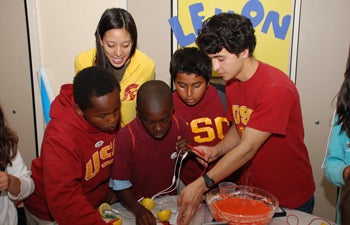Eye-Opening Science
Fourth-grader Zakar Martin cut a lemon in half. He pushed a nail into the squishy side of one half and a penny into the other half of the fruit’s pulpy side. Then he clamped one end of a wire to the copper penny and the other end to the zinc nail. A volt meter indicated electricity was flowing through the wires.
The 32nd Street School student’s eyes widened.
“I liked science before, but I really like it now,” Zakar said enthusiastically. “What I like most about it is learning that an everyday fruit can make energy. That’s pretty cool.”
For Zakar and 42 other youngsters, the exercise helped to demystify the complexities of science. A main objective of the Young Scientists Program (YSP) based in USC Dornsife’s Joint Educational Project (JEP) is to erase any intimidation toward physics, science and engineering. Another objective of the program is to encourage these students to think about careers in science. YSP is responding to President Barack Obama’s national STEM (Science, Technology, Engineering and Math) initiative to increase student achievements in science and math over the next decade.
On April 26, the children participated in the YSP Energy and Motion Studio hosted by JEP in partnership with USC’s Women in Science and Engineering (WiSE).
“We really want to get fourth and fifth graders ready for life sciences or engineering,” said Nadine Afari, YSP program director and lecturer with the USC Viterbi School of Engineering. “This Energy and Motion Studio is laying a foundation that physics, math and science can be fun and interesting.”
Under YSP, USC graduate students and undergraduates teach natural, life, earth and engineering sciences to fourth and fifth graders at five USC community schools during their allotted science class time.
As they rotated between four stations, students received a crash course on the principles essential to learning how energy and motion work. Each station allowed the young scientists to put into practice what they learned about food energy, light energy, matter, atoms and Newton’s laws of motion.
Allyson Brown, a senior majoring in neuroscience with minors in forensics and criminality in USC Dornsife, was among the mentors.

Hammering echoed through the auditorium as students used ply wood, nails, rubber bands and a variety of other items to build a contraption similar to the Mouse Trap board game at the “Rube Goldberg Prototype” station. Photo by Nick Pittarides.
“It is important that they have a strong science base,” said Brown, a YSP teaching assistant. “We want them to understand science so they are not scared away from such a wonderful possible field of study.”
At the “Lemon Battery and Squishy Circuit” station, kids tasted astronaut food and learned that the calories in the treats converted to energy.
Alice Hall-Partyka, a sophomore majoring in environmental studies in USC Dornsife, helped fourth-grader Steven Delu create a “lemon battery.”
“I’ve noticed in working with the students that they love science and they tell me they want to pursue careers in science,” said Hall-Partyka, a YSP volunteer. “Doing activities like this helps them understand science in a way a textbook doesn’t.”
Handling the lemon, Steven didn’t mind getting his hands sticky as he carefully connected wires to a penny and nail.
“It was fun,” Steven said. “I learned than if you use liquids like a grapefruit or lemon and you put a metal and copper object in it than you can make electricity.”

Students at 32nd Street School had the chance to learn about physics, science and engineering during the Young Scientists Program’s Energy and Motion Studio hosted by the Joint Education Project (JEP) based in USC Dornsife in partnership with USC’s Women in Science and Engineering (WiSE). The children learned about energy at the “Lemon Battery and Squishy Circuit” station where they built their own “lemon battery.” Photo by Nick Pittarides.
“I didn’t know that stuff could make energy,” fourth-grader Amin Zain added.
Throughout the afternoon students learned about force and the center of mass at the “WiSE Dance and Newton’s Laws” station where they watched a video on movement to better understand how motion relates to their body.
In the “WiSE Balance and Core Motion” station, the children learned about weight distribution and balance as they stood on two feet, then one.
Jill McNitt-Gray, professor of biological sciences and director of the Integrative and Evolutionary Biology Graduate Program in USC Dornsife, helped students understand the importance of nutrition and body movement. If you want to generate a force such as throwing a ball, she told the children, you must have the energy to do so, which is where nutrition comes in.
“We wanted to show them that science is fun and it’s meaningful to how they interact with the world,” said McNitt-Gray who holds a joint appointment in biomedical engineering at USC Viterbi School of Engineering. “They had a good time.”
Tina Koneazny, associate director JEP’s administration and educational outreach, was pleased with the event’s success.
“You have a picture in your mind about what it might look like and it’s great to see it with your own eyes,” Koneazny said. “It’s great to see the kids laughing, learning and having fun.”
For fourth-grader Danielle Lopez, the studio planted a seed in her brain.
“Maybe I’ll be a scientist,” she said.